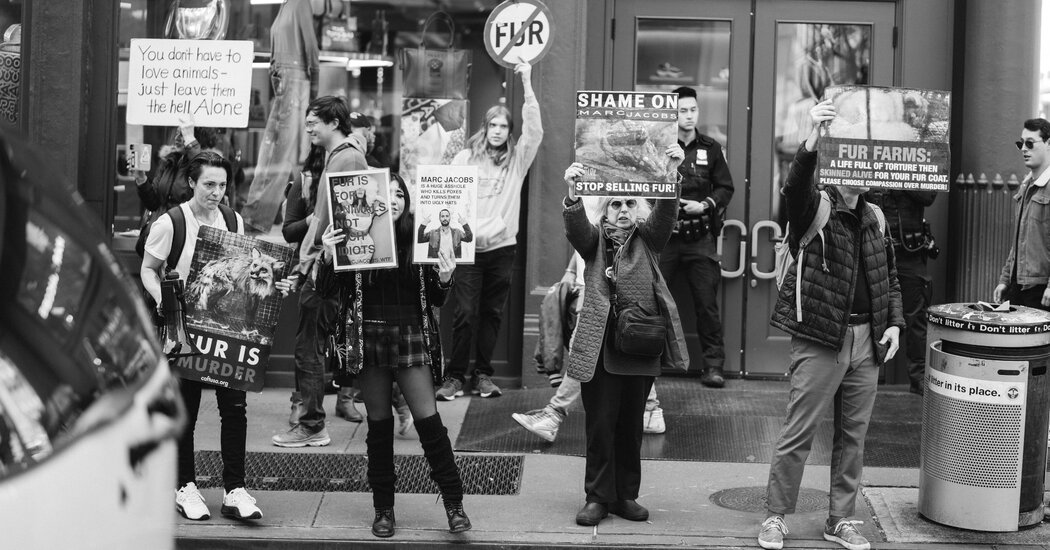A new frontier has opened in fashion’s fur wars, as protesters targeted the homes of more than a dozen employees of Marc Jacobs in recent months, using signs, noisemakers and fake blood in an effort to force the designer to officially renounce the use of fur in his collections.
Over the weekend, Mr. Jacobs accused the protesters of “bullying” in a statement on Instagram, but averred: His brand “does not work in, use or sell fur, nor will we in the future.” He also emphasized that he had not used fur in any of his own brand’s collections since 2018.
“This organization has made it clear that they will not stop their violence toward Marc Jacobs unless they get the statement they want,” Mr. Jacobs wrote. “While I don’t condone the behavior of this organization, I will always do what I can to protect, honor and respect the lives and well-being of the people I work with.”
The organization referenced by Mr. Jacobs is the Coalition to Abolish the Fur Trade, or CAFT, a group that selects targets and disseminates information and resources to anti-fur activists on the ground.
“We were ecstatic,” Matthew Klein, the executive director of CAFT USA, said of Mr. Jacobs’s statement, though he disputed the description of the protests as violent: “Home protest is protected by the First Amendment, and has a long and proud history of use by the labor and civil rights movements.”
According to Mr. Klein, CAFT has been protesting Marc Jacobs since June 2023 — a few months after the company collaborated on a runway show with the Italian brand Fendi.
That collection included large fox fur hats described by Mr. Jacobs as “upcycled.” Kim Jones, the creative director of Fendi women’s wear, confirmed the fur came from a vintage piece. The hats were used as a runway accessory and never produced for public sale.
“It was the cultural relevance that Marc Jacobs had in fashion that made him a priority for our campaign,” Mr. Klein said, calling the designer “extremely influential” to emerging brands.
The protests began outside stores and offices. But until this weekend, the brand’s only public response seemed to be an Instagram post from Mr. Jacobs’s husband, which personally criticized one particular activist. “It didn’t have the result that we wanted — a fur-free policy — but rather ridicule,” Mr. Klein said.
The campaign escalated in February, with protesters gathering outside the homes of Marc Jacobs employees. At least 18 employees were targeted, some multiple times, in New York City, Las Vegas and Austin, Mr. Klein said. (Since February, more than 100 protests have been held, he added, including Mr. Jacobs being confronted in a car on his way to the Met Gala.)
Michael Ariano, the global head of public relations for Marc Jacobs, said he was followed down the street by a shouting group of protesters, his neighbors were harassed, and slogans such as “Michael Ariano is a Murderer” were written in chalk on the ground in front of his apartment.
In the last week, there have been six arrests related to the protests, Mr. Klein said, including an incident involving a broken window at the company’s headquarters in SoHo. During another incident, the husband of a Marc Jacobs executive was also arrested after taking a cellphone belonging to a protester outside of their Brooklyn home, Mr. Ariano confirmed.
“It’s very frustrating, because the same principles and laws that we revere can be taken advantage of and turn into radical harassment,” Mr. Ariano said, referring to the first amendment.
The protests have affected not only Marc Jacobs employees, but their neighbors as well. Laura Neilson, a writer who lives in the same East Village building as a senior director at Marc Jacobs, said she spent Memorial Day helping to clean up fake blood splattered onto the facade and chalk etched on the sidewalk spanning the length of her 60-unit building.
About two dozen protesters demonstrated for about 30 minutes. They buzzed apartment doors, attempting to get inside the building, Ms. Neilson said. The target of the protest was not home at the time, but an elderly neighbor and several pets were distressed by the commotion.
“It got really scary,” said Ms. Neilson, who has contributed freelance articles to The New York Times. “It looked like a zombie apocalypse, the way they were all standing out in front, peering through the windows.”
LVMH, the French luxury group that owns Marc Jacobs, declined to comment.
These protests represent an escalation of the tactics of anti-fur groups such as PETA, which have previously focused on disrupting runway shows and store operations.
The anti-fur movement has been largely successful in its efforts to force fashion houses to stop using skins, with almost every runway brand adopting fake fur as a fabric and eschewing the use of former luxury staples such as mink and sable. Glossy magazines including Elle have likewise stopped photographing real fur, and department stores such as Neiman Marcus, Saks and Nordstrom no longer sell real fur.
As a result, the fur-free cause has turned to leather as well as exotic skins such as python and ostrich. In a statement, Tracy Reiman, executive vice president of PETA, applauded Mr. Jacobs’s official renunciation of fur and said, “we look to Jacobs to save more animals’ skins by banning leather, too.”
Mr. Klein said CAFT will soon be announcing plans to target the fashion brand Max Mara over the use of fur.
“It’s easy to ignore us when we’re outside of one of their stores,” said Mr. Klein, indicating up to 40 Marc Jacobs employees were on the list for future home protests. “It’s impossible to ignore us when we’re outside their homes.”







